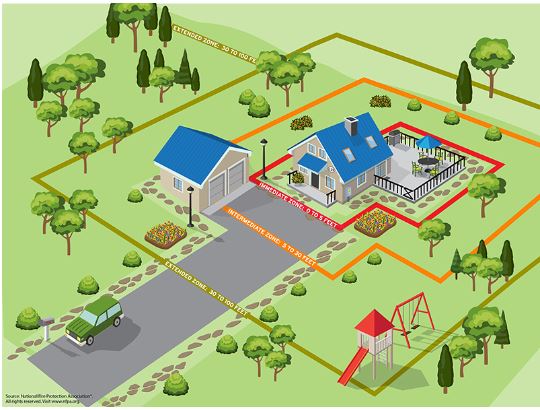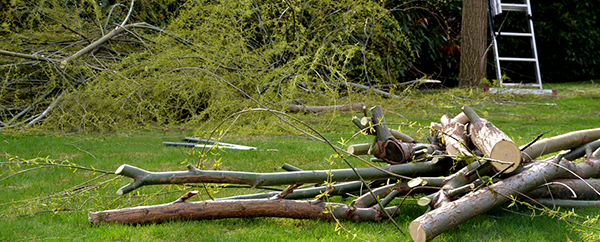Lower your risk of damage with these wildfire preparedness tips
- Communities across the U.S. and Canada participate in Wildfire Preparedness Day to lower their risk of wildfire damage.
- Wildfires across the United States have cost more than 200 lives and more than $45 billion in property losses in just the last three years.
- Keep reading to learn how to protect your property from wildfire risk.
Wildfire Preparedness Day is a special community event encouraging people and organizations to come together on a single day and take action to reduce wildfire risks. Held annually in the U.S. and Canada on the first Saturday in May, the event is supported by the National Fire Protection Association® (NFPA®).
 Wildfires across the United States have cost more than 200 lives and more than $45 billion in property losses in just the last three years. That’s why it’s so important to take steps to improve the wildfire safety of your home and community
Wildfires across the United States have cost more than 200 lives and more than $45 billion in property losses in just the last three years. That’s why it’s so important to take steps to improve the wildfire safety of your home and community
This year’s focus is on what residents can do on and around their home to help protect against the threat of wildfires. Agents, share this wildfire preparedness article with your homeowners and business owners in high-to-medium risk areas.
Studies show that measures taken at the home and in the area within 100 feet of it, known as the Home Ignition Zone (HIZ), have a significant impact on minimizing damage and loss. Something as simple as clearing the immediate 5-foot zone around the home can assist in making a huge difference in avoiding a catastrophe.
Related: Wildfire mitigation at home: How to protect your property
Protect your property with these wildfire preparedness tips
You may be asking, “What can I accomplish in just one day? And how do I start?” There’s plenty to be done in just a day. The NFPA suggests the following:
Check:
- Can you see your home’s address number from the street? How about your neighbors’? If not, trim overgrown vegetation covering or blocking the numbers on your homes in case firefighters need to find you.
- Locate two alternate routes out of your neighborhood (besides the one normally used) and plan and practice a family evacuation drill using those alternate routes.
- Measure how close wood piles are located to the home. If any are closer than 30 feet, move them farther away from structures. Screen or box-in areas below patios and decks with wire screening no larger than 1/8-inch mesh to help keep embers out during a wildfire.
- Check your possessions. Get tips from the Insurance Information Institute on how to document your belongings.
- Check in on others! Help elderly relatives or neighbors enter emergency numbers into their cell phones. Using large type, post their phone number and street address above their landline phone so it can easily be seen when providing information to an emergency dispatcher
Clear:
- Rake and remove pine needles and dry leaves to a minimum of 3 to 5 feet from a home’s foundation. Over time, continue up to a 30-foot distance around the home. Dispose of collected debris in appropriate trash receptacles.
- Sweep porches and decks, clearing them of leaves and pine needles. Rake under decks, porches, sheds, and play structures.
- On mature trees, use hand pruners and loppers to remove low-hanging tree branches up to a height of 4 feet from the ground (specific height depends on the type and size of tree). Collect downed tree limbs and broken branches and take them to a disposal site.
- Remove items stored under decks and porches and relocate them to a storage area. Gasoline cans and portable propane tanks should never be stored indoors or near the home.
- Join forces with neighbors and pool your resources to pay for a chipper service to help clear debris.
- Clear out your closets! Hold a garage sale and donate the proceeds to your local fire department’s wildland fire team.
Related: Wildfire safety tips for businesses
Communicate:
- Create a family communication plan and build or update a 72-hour evacuation kit for you, your family, and your pets.
- Send free Firewise USA® and emergency preparedness tips through social media or text messaging
- Contact the local Office of Emergency Management about registering your mobile number to receive emergency notifications on your own device. After registering your own number, register those of your family.
- Inform young adults who babysit outside the home that they need to learn the family’s emergency plan for wildfires and evacuations.
- Work with neighbors to develop a phone tree that can be used to alert everyone about a fire or evacuation.
Related: Wildfire mitigation starts with a plan
Whether your homeowners and business owners choose to use these wildfire preparedness tips on May 4 or any other day, they can greatly reduce their chances of experiencing wildfire damage. For more information on Wildfire Preparedness Day, go to https://www.nfpa.org/events/wildfire-community-preparedness-day.

